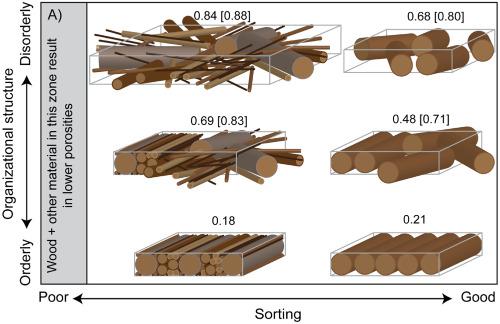当前位置:
X-MOL 学术
›
Earth Surf.Process. Land.
›
论文详情
Our official English website, www.x-mol.net, welcomes your
feedback! (Note: you will need to create a separate account there.)
Porosity problems: Comparing and reviewing methods for estimating porosity and volume of wood jams in the field
Earth Surface Processes and Landforms ( IF 2.8 ) Pub Date : 2020-07-30 , DOI: 10.1002/esp.4969 Bridget Livers 1 , Katherine B. Lininger 2 , Natalie Kramer 3, 4 , Alicia Sendrowski 4
Earth Surface Processes and Landforms ( IF 2.8 ) Pub Date : 2020-07-30 , DOI: 10.1002/esp.4969 Bridget Livers 1 , Katherine B. Lininger 2 , Natalie Kramer 3, 4 , Alicia Sendrowski 4
Affiliation

|
Porosity, or void space, of large wood jams in stream systems has implications for estimating wood volumes and carbon storage, the impacts of jams on geomorphic and ecological processes, and instream habitat. Estimating porosity and jam dimensions (i.e. jam volume) in the field is a common method of measuring wood volume in jams. However, very few studies explicitly address the porosity values in jams, how porosity is calculated and assessed for accuracy, and the effect such estimates have on carbon and wood budgets in river corridors. We compare methods to estimate jam porosity and wood volume using field data from four different depositional environments in North America (jam types include small in‐channel jams, large channel‐margin jams, a large island apex jam, and a large coastal jam), and compare the results with previous studies. We find that visual estimates remain the most time‐efficient method for porosity estimation in the field, although they appear to underpredict back‐calculated porosity values; the accuracy of jam porosity, and thus wood volume, estimates are difficult to definitively measure. We also find that porosity appears to be scale invariant, dictated mostly by jam type, (which is influenced by depositional processes), rather than the size of the jam. Wood piece sorting and structural organization are likely the most influential properties on jam porosity, and these factors vary according to depositional environment. We provide a framework and conceptual model that uses these factors to demonstrate how modeled jam porosity values differ and give recommendations as a catalyst for future work on porosity of wood jams. We conclude that jam type and size and/or the study goals may dictate which porosity method is the most appropriate, and we call for greater transparency and reporting of porosity methods in future studies. © 2020 John Wiley & Sons, Ltd.
中文翻译:

孔隙率问题:现场评估和评估果酱的孔隙率和体积的方法
溪流系统中大型木材果酱的孔隙度或空隙空间,对估计木材的体积和碳储量,果酱对地貌和生态过程的影响以及河内生境具有影响。在现场估算孔隙率和果酱尺寸(即果酱体积)是测量果酱中木材体积的常用方法。但是,很少有研究明确地解决果酱中的孔隙率值,如何计算和评估孔隙率的准确性以及这种估计对河道碳和木材预算的影响。我们比较了使用北美四种不同沉积环境的现场数据估算果酱孔隙率和木材量的方法(堵塞类型包括小型通道内堵塞,大型通道边缘堵塞,大岛峰堵塞和大型沿海堵塞),并将结果与以前的研究进行比较。我们发现,尽管目测估计似乎低估了反算的孔隙率值,但它仍然是现场孔隙率估计最省时的方法。果酱孔隙率的准确性以及木材的体积估计很难确定。我们还发现,孔隙率似乎是尺度不变的,主要由堵塞类型(受沉积过程影响)决定,而不是堵塞的大小。木质碎片的分类和结构组织可能是影响果酱孔隙率的最重要属性,并且这些因素会根据沉积环境而变化。我们提供了一个框架和概念模型,使用这些因素来证明建模的果酱孔隙率值如何不同,并提出建议,以作为未来有关木材果酱孔隙率工作的催化剂。我们得出的结论是,果酱的类型和大小和/或研究目标可能决定哪种孔隙率方法最合适,并且我们呼吁在未来的研究中提高透明度并报告孔隙率方法。分级为4 +©2020 John Wiley&Sons,Ltd.
更新日期:2020-07-30
中文翻译:

孔隙率问题:现场评估和评估果酱的孔隙率和体积的方法
溪流系统中大型木材果酱的孔隙度或空隙空间,对估计木材的体积和碳储量,果酱对地貌和生态过程的影响以及河内生境具有影响。在现场估算孔隙率和果酱尺寸(即果酱体积)是测量果酱中木材体积的常用方法。但是,很少有研究明确地解决果酱中的孔隙率值,如何计算和评估孔隙率的准确性以及这种估计对河道碳和木材预算的影响。我们比较了使用北美四种不同沉积环境的现场数据估算果酱孔隙率和木材量的方法(堵塞类型包括小型通道内堵塞,大型通道边缘堵塞,大岛峰堵塞和大型沿海堵塞),并将结果与以前的研究进行比较。我们发现,尽管目测估计似乎低估了反算的孔隙率值,但它仍然是现场孔隙率估计最省时的方法。果酱孔隙率的准确性以及木材的体积估计很难确定。我们还发现,孔隙率似乎是尺度不变的,主要由堵塞类型(受沉积过程影响)决定,而不是堵塞的大小。木质碎片的分类和结构组织可能是影响果酱孔隙率的最重要属性,并且这些因素会根据沉积环境而变化。我们提供了一个框架和概念模型,使用这些因素来证明建模的果酱孔隙率值如何不同,并提出建议,以作为未来有关木材果酱孔隙率工作的催化剂。我们得出的结论是,果酱的类型和大小和/或研究目标可能决定哪种孔隙率方法最合适,并且我们呼吁在未来的研究中提高透明度并报告孔隙率方法。分级为4 +©2020 John Wiley&Sons,Ltd.











































 京公网安备 11010802027423号
京公网安备 11010802027423号